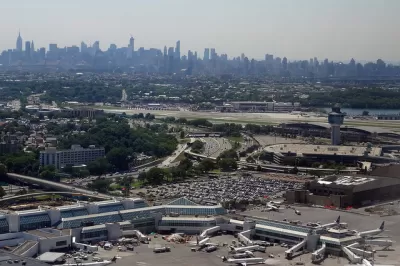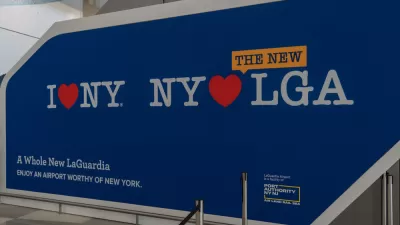It may be too late to pivot on the recently announced rebuilding of New York City's LaGuardia Airport, but Jim Venturi has some ideas about how New York can solve two critical problems—one infrastructural, one humanitarian—at the same time.

To many air travelers, New York's LaGuardia Airport feels like a prison. It suffers notorious delays, is difficult to get to, and, according to surveys, is as unpleasant as airports get. But most LaGuardia customers can only imagine what goes on a few hundred meters outside of LaGuardia's boundaries at the city's Rikers Island prison complex.
This week federal, city, and state officials announced that LaGuardia would be torn down and replaced with a brand-new terminal, to the tune of $4 billion. Writing for The Architect's Newspaper, Jim Venturi argues that the redesign of LaGuardia should think bigger: it should also include the demolition of Rikers.
Rikers' ten jails house between 12,000 and 15,000 prisoners in any given day. Many of these jails are in ghastly shape, with abuse and mismanagement fairly well documented. Venturi proposes that Rikers' jails be relocated and spread out among the five boroughs, in part to make them more accessible and therefore more human. "Any jail on an island will be toxic," writes Venturi. In Rikers' place, Venturi proposes that LaGuardia absorb the island (via landfill) and replace it with a vast runway complex that could make it "the world's leading airport....By adding this infrastructure and increasing airport capacity, we would gain a significant opportunity to expand New York City’s economy beyond Manhattan."
Not only that, Venturi has a plan for transportation to the airport, proposing a new train station in the Bronx that would take pressure off Manhattan's notorious Penn Station and serve as a high-capacity transfer point for the new LaGuardia.
FULL STORY: Comment: Instead of closing LaGuardia, let's fix it and close Rikers

Planetizen Federal Action Tracker
A weekly monitor of how Trump’s orders and actions are impacting planners and planning in America.

Restaurant Patios Were a Pandemic Win — Why Were They so Hard to Keep?
Social distancing requirements and changes in travel patterns prompted cities to pilot new uses for street and sidewalk space. Then it got complicated.

Map: Where Senate Republicans Want to Sell Your Public Lands
For public land advocates, the Senate Republicans’ proposal to sell millions of acres of public land in the West is “the biggest fight of their careers.”

Maui's Vacation Rental Debate Turns Ugly
Verbal attacks, misinformation campaigns and fistfights plague a high-stakes debate to convert thousands of vacation rentals into long-term housing.

San Francisco Suspends Traffic Calming Amidst Record Deaths
Citing “a challenging fiscal landscape,” the city will cease the program on the heels of 42 traffic deaths, including 24 pedestrians.

California Homeless Arrests, Citations Spike After Ruling
An investigation reveals that anti-homeless actions increased up to 500% after Grants Pass v. Johnson — even in cities claiming no policy change.
Urban Design for Planners 1: Software Tools
This six-course series explores essential urban design concepts using open source software and equips planners with the tools they need to participate fully in the urban design process.
Planning for Universal Design
Learn the tools for implementing Universal Design in planning regulations.
Heyer Gruel & Associates PA
JM Goldson LLC
Custer County Colorado
City of Camden Redevelopment Agency
City of Astoria
Transportation Research & Education Center (TREC) at Portland State University
Camden Redevelopment Agency
City of Claremont
Municipality of Princeton (NJ)



























